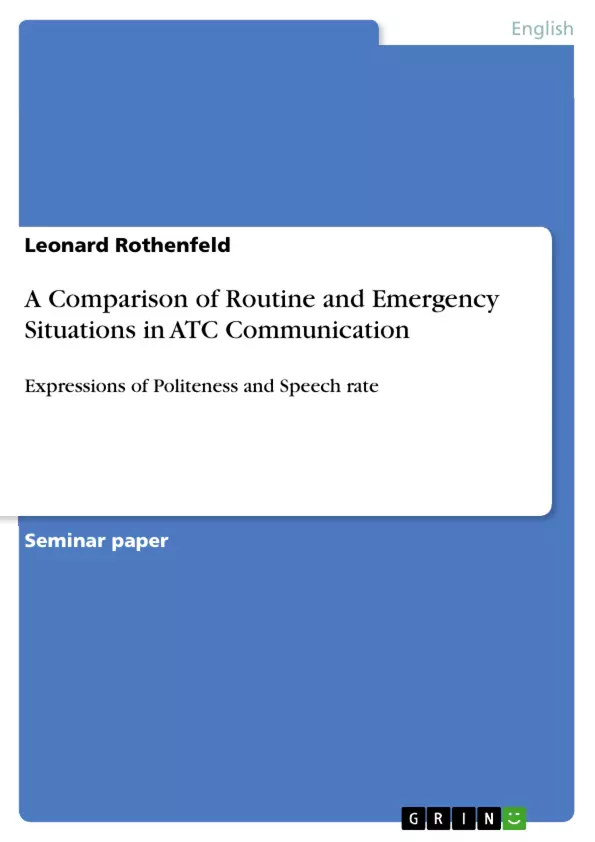This research paper explores the linguistic differences between routine and emergency situations in air traffic control (ATC) communication, focusing on politeness markers and speech rate. By analyzing real-life pilot-controller exchanges, the study examines how politeness and speech tempo vary under different conditions, providing insights into their impact on communication efficiency and safety. The findings aim to contribute to a better understanding of how language use in high-stress environments like aviation can influence outcomes. This work is ideal for linguists, aviation professionals, and anyone interested in the role of language in critical communication settings.
Inhaltsverzeichnis (Table of Contents)
- 1. Introduction
- 2. Literature Review
- 2.1. Politeness
- 2.1.1. International Civil Aviation Organization
- 2.1.2. Politeness Theory
- 2.1.3. Consequences of Politeness
- 2.1.4. Mitigated Speech
- 2.2. Speech Rate
- 2.1. Politeness
- 3. Research Question
- 4. Data & Methodology
- 5. Analysis
- 5.1. Routine Situations
- 5.1.1. Politeness Markers by Controllers
- 5.1.2. Politeness Markers by Pilots
- 5.2. Emergency Situations
- 5.2.1. Speech Rate
- 5.2.2. Politeness
- 5.3. Direct Comparison
- 5.3.1. Speech Rate
- 5.3.2. Politeness
- 5.1. Routine Situations
- 6. Results
- 7. Discussion
Zielsetzung und Themenschwerpunkte (Objectives and Key Themes)
This research paper investigates the use of politeness expressions and speech rate in air traffic control (ATC) communication, comparing routine and emergency situations. It aims to provide an in-depth analysis of existing politeness theory and speech rate research, applying these frameworks to real-life ATC transcripts.
- The impact of politeness on ATC communication efficiency.
- The relationship between politeness strategies and emergency/routine contexts.
- Differences in speech rate during routine and emergency situations.
- Analysis of politeness markers used by both controllers and pilots.
- Application of politeness theory (Brown & Levinson) to ATC communication.
Zusammenfassung der Kapitel (Chapter Summaries)
Chapter 1: Introduction introduces the research topic by highlighting a real-world aviation accident potentially linked to excessive politeness. It outlines the paper's objectives and structure.
Chapter 2: Literature Review examines existing research on politeness theory, focusing on Brown and Levinson's framework, and its application to aviation communication. It also reviews research on speech rate in ATC communication and the impact of politeness on communication efficiency. The chapter discusses the International Civil Aviation Organization's (ICAO) guidelines on communication phraseology and standard English.
Chapter 3: Research Question states the specific research question(s) addressed in the paper.
Chapter 4: Data & Methodology describes the data sources (ATC communication corpora) and the methodologies used in the analysis.
Chapter 5: Analysis presents the analysis of routine and emergency ATC transcripts focusing on politeness markers and speech rate in both controller and pilot communication. This chapter also includes a direct comparison of speech rate and politeness in both contexts.
Chapter 6: Results presents the findings of the analysis.
Chapter 7: Discussion discusses the findings in relation to previous research.
Schlüsselwörter (Keywords)
Air traffic control, aviation communication, politeness theory, speech rate, emergency situations, routine situations, Brown & Levinson, ICAO, phraseology, mitigated speech, ATC communication corpora.
- Quote paper
- Leonard Rothenfeld (Author), 2023, A Comparison of Routine and Emergency Situations in ATC Communication, Munich, GRIN Verlag, https://www.grin.com/document/1518376



